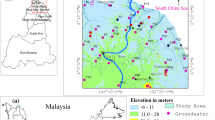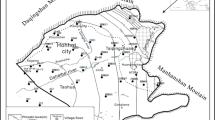Abstract
Stable isotopes (δ18O and δ2H), 14C and groundwater chemistry were used in this study for gaining insight into the recharge mechanisms and groundwater geochemical evolution in a semi-arid region of northern Iraq. The 3,185 km2 large catchment of the Al-Khazir Gomal Basin is divided into three regions (south, central, and north) depending on structural and geological aspects. In terms of hydrogeology, the vast syncline in the central part of the watershed is considered to be the most important region regarding groundwater quality and quantity. Groundwater samples of both confined and unconfined aquifers plot on or slightly above the local meteoric water line and the slope of the δ18O and δ2H regression line for the confined and unconfined aquifers is 7.26 and 7.01, respectively. This is interpreted as an indicator of considerable recharge with short residence time for the shallow groundwater, excluding the effect of evaporation before infiltration. This assumption was supported by low chloride concentrations, groundwater Ca-HCO3 type and the high values of 14C activities. The variations in stable isotopes and 14C in the confined aquifer support the assumption of existence of different recharge resources and mechanisms. Hydrogeochemically, there are three main mechanisms contributing to the chemical evolution of the groundwater; these are the preferential chemical weathering of the carbonate cement of the sandstones, geochemical weathering of silicate minerals and cation exchange processes. Meteoric NaCl is considered to be the main source of dissolved Na and Cl ions in freshwater samples. Additional Na might stem from cation exchange with dissolved Ca and Mg.








Similar content being viewed by others
References
Adar EM, Neuman SP, Woolhiser DA (1988) Estimation of spatial recharge distribution using environmental isotopes and hydrochemical data, I. Mathematical model and application to synthetic data. J Hydrol 97(3–4):251–277
Al-Manmi DA (2008) Water resources management in Rania area. University of Baghdad, Sulaimaniyah NE-Iraq
Al-Sam S, Hanna F (1981) Evaluation of groundwater resources in Al-Khazir Gomal Basin. Rep. No.1270, Iraq-Baghdad
Boronina A, Balderena W, Renardb P, Stichler W (2005) Study of stable isotopes in the Kouris catchment (Cyprus) for the description of the regional groundwater flow. J Hydrol 308(1–4):214–226
Carrillo-Rivera JJ, Clark ID, Fritz P (1992) Investigating recharge of shallow and Paleo-Groundwaters in the Villa De Reyes Basin, SLP, Mexico, with environmental isotopes. Appl Hydrogeol 1(4):35–48
Clark ID, Fritz P (1999) Environmental isotopes in hydrogeology Second Edi., Ottawa and Leipzig. Lewis Publishers, New York
Deutsch WJ (1997) Groundwater geochemistry: fundamentals and application to contamination. CRC, Boca Raton: Lewis Publishers, US
Drever JI (1982) The geochemistry of natural waters: surface and groundwater environments N. J. Englewood Cliffs, ed., Prentice-Hall
Edmunds WM, Smedley PL (2000) Residence time indicators in groundwater: the East Midlands Triassic sandstone aquifer. Appl Geochem 15(6):737–752
EEA (2000) Groundwater quality and quantity in Europe. Environmental assessment report No 3., European Environment Agency, Copenhagen
Hamamin D, Ali S (2012) Hydrodynamic study of karstic and intergranular aquifers using isotope geochemistry in Basara basin, Sulaimani, North-Eastern Iraq. Arab J Geosci 6:1–8
Horst A, Mahlknecht J, Merkel BJ (2007) Estimating groundwater mixing and origin in an overexploited aquifer in Guanajuato, Mexico, using stable isotopes (strontium-87, carbon-13, deuterium and oxygen-18)†. Isot Environ Health Stud 43(4):323–338
International Atomic Energy Agency IAEA (2005) Isotopic composition of precipitation in the Mediterranean Basin in relation to air circulation patterns and climate. Austria, Vienna
Jassas H, Merkel B (2014) Estimating groundwater recharge in the semiarid Al-khazir Gomal Basin North Iraq. Water 6(8):2467–2481
Leibundgut C, Piotr M, Christoph K (2011) Tracers in hydrology. Wiley, New York
Mawlood D (2003) Application of isotope hydrology studies considering the specific climate, hydrogeological and geological conditions in order to research underground water resources in a specific area in the near East. Vienna University of Technology
Merlivat L, Jean J (1979) Global climatic interpretation of the Deuterium–Oxygen 18 relationship for precipitation. J Geophys Res 84:5029–5033
Négrel P, Petelet-Giraud E (2005) Strontium isotopes as tracers of groundwater-induced floods: the Somme case study (France). J Hydrol 305(1–4):99–119
Négrel P, Roy S (1998) Chemistry of rainwater in the Massif Central (France): a strontium isotope and major element study. Appl Geochem 13(8):941–952
Parkhurst DL, Appelo CAJ (1999) Users guide to PHREEQC (version 2)—A computer program for speciation, batch reaction, one-dimensional transport and inverse geochemical calculations., Denver, Colorado
Pearson JR, Hanshaw BB (1970) Sources of dissolved carbonate species in groundwater and their effects on carbon-14 dating. Isot. Hydrol., pp.271–286
Rozanski K, Aragaus L, Gonfiantini R. (1993) Isotopic patterns in modern global precipitation. In climate change in continental isotopic records. Geophys Monogr Ser Washington, DC: AGU, pp. 1–36
Sami K (1992) Recharge mechanisms and geochemical processes in a semi-arid sedimentary basin, Eastern Cape South Africa. J Hydrol 139(1–4):27–48
Sidle WC (1998) Environmental isotopes for resolution of hydrology problems. Environ Monit Assess 52(3):389–410
SissakianVK (1998) The geology of Erbil and Mahabad Quadrangles sheet NJ-38-14 and NJ-38-15, Scale: 1:250000, Baghdad
Stallard RF, Edmond JM (1983) Geochemistry of Amazon, the influence of geology and weathering environment on the dissolved load. J Geophys Res 88:9671–9688
UNEP (1992) World atlas of desertification, London, UK
Yeh H, Cheng H, Kuo C, Po H, Chung H (2009) Using stable isotopes for assessing the hydrologic characteristics and sources of groundwater recharge. J Environ Eng Manage 19(4):185–191
Zarei M, Raeisi E, Merkel B, Kummer N (2013) Identifying sources of salinization using hydrochemical and isotopic techniques, Konarsiah Iran. Environ Earth Sci 70(2):587–604
Zongyu C, Zhenlong N, Zhaoji Z, Jixiang Q, Yunju N (2005) Isotopes and sustainability of ground water resources, North China Plain. Ground Water, 43(4), pp.485–493. Available at: http://dx.doi.org/10.1111/j.1745-6584.2005.0038.x
Acknowledgments
This work was supported by the German Academic Exchange Service (DAAD), the Geological Survey of Iraq (GEOSURV) and the Iraqi Ministry of Higher Education and Scientific Research. Also, the authors want to sincerely thank the staff of the laboratories of the Hydrogeology Department of TU Bergakademie Freiberg, Germany (Frau Schlothmann, Dr. Kummer, and Herr Peter) for assisting in conducting the hydrochemical analyses.
Author information
Authors and Affiliations
Corresponding author
Rights and permissions
About this article
Cite this article
Jassas, H.A., Merkel, B.J. Investigating groundwater recharge by means of stable isotopes in the Al-Khazir Gomal Basin, northern Iraq. Environ Earth Sci 73, 8533–8546 (2015). https://doi.org/10.1007/s12665-015-4013-7
Received:
Accepted:
Published:
Issue Date:
DOI: https://doi.org/10.1007/s12665-015-4013-7




